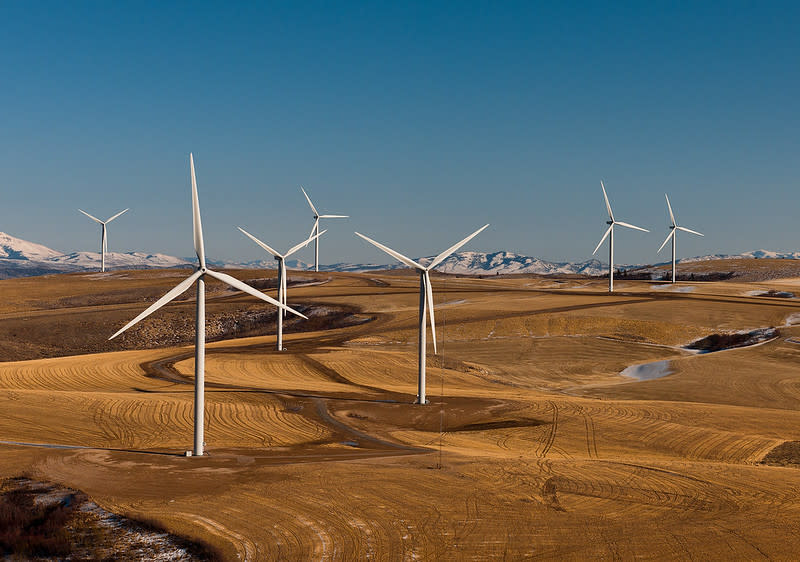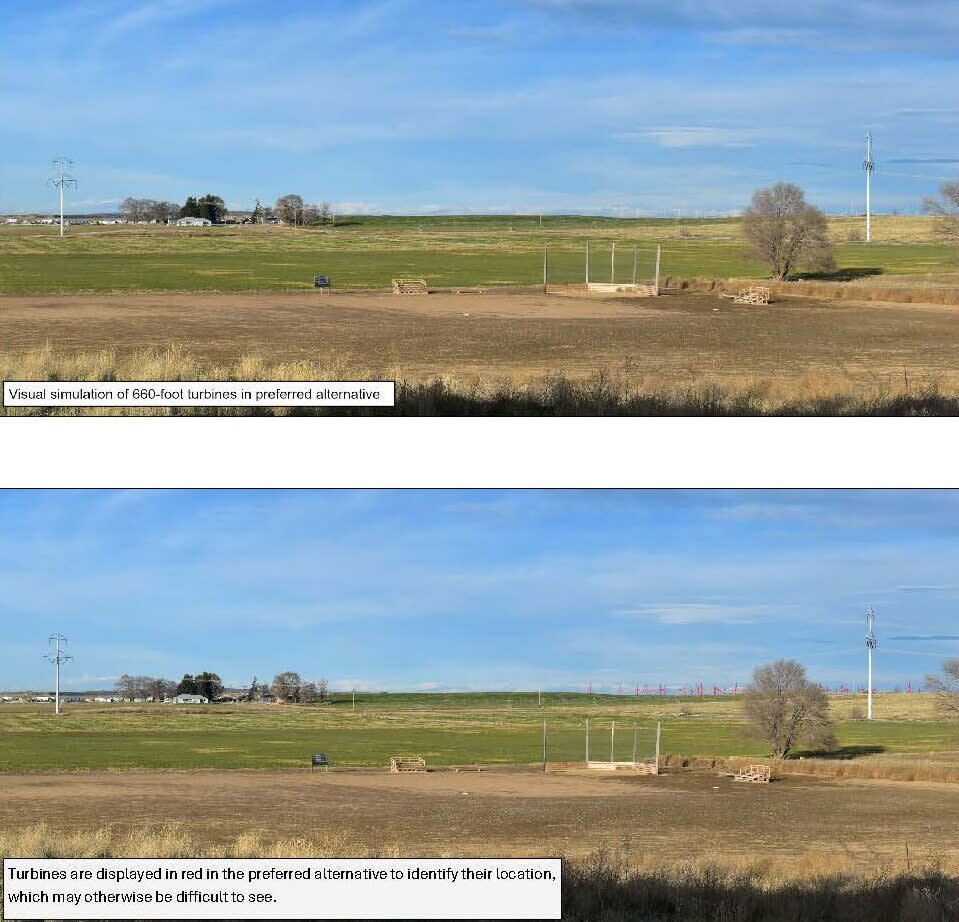Idaho wind project moves forward at half of original proposed size

The Snake River Plain in southern Idaho represents the greatest wind resource potential in Idaho, according to Idaho’s Office of Energy and Mineral Resources’ 2024 Energy Landscape Report. Idaho’s wind production grew 1,184% from 2008 to 2021, and wind makes up 17% of Idaho's electricity. Wind energy in Idaho is provided by nearly 550 turbines, including the ones on this wind farm in Power County. (U.S. Department of Energy)
The Lava Ridge Wind Project is moving forward under a new plan that shrinks the project to nearly half of its originally proposed size.
The Bureau of Land Management on June 6 issued its final environmental review, which selected an alternative model for the project after taking into consideration input from landowners, ranchers, Native American tribes and public officials. The finalization for the preferred alternative would take place later this summer, Magic Valley Energy spokesperson Amy Schutte told the Sun.
Magic Valley Energy, an affiliate of LS Power, seeks to build the wind development about 25 miles northeast of Twin Falls. The original proposal for the wind project would have sat on 197,000 acres of land, and consisted of 400 turbines up to 740 feet in height. The bureau’s preferred alternative shrinks the project to sit on 104,000 acres of land, consisting of 241 turbines with a maximum height of 660 feet.
According to the BLM, the preferred alternative reduces potential impacts to sage grouse, large wildlife migration routes, cultural resources, Jerome County Airport and agricultural aviation uses, public land ranchers, and private landowners.
The alternative also addresses concerns from Friends of Minidoka, a nonprofit organization based in Jerome that preserves the Minidoka National Historic Site, a site of a former concentration camp for Japanese Americans during World War II.
The organization opposed the wind development, arguing it would cast an imposing view on their site, the Idaho Statesman reported. Under the original proposal, it would have been as close as two miles away from the site. In the alternative, the closest wind turbine would be nine miles away from the historical site.
Luke Papez, senior director of project development for LS Power, said in a news release the preferred alternative is a balance between protecting environmental resources and the demand for domestic energy production.
“Our goal is to meet rising energy demand while forging strong relationships and partnerships within the local community,” Papez said in the release. “This goal is crucial to ensure sustainable and beneficial development for the Magic Valley region of Idaho.”

Idaho officials oppose Lava Ridge Wind Project
Since the early stages of the project’s development, the wind project has sparked controversy. Idaho lawmakers in 2023 passed a resolution expressing concerns about the project.
Thursday’s BLM decision sparked renewed opposition from Idaho public officials.
The same day the decision was issued, Idaho Gov. Brad Little, Lt. Gov. Scott Bedke, U.S. Senators Mike Crapo and Jim Risch and Congressman Mike Simpson all issued statements in a news release opposing the Bureau of Land Management’s decision.
The Biden administration has a goal of achieving net-zero carbon emissions by 2050, or when the amount of greenhouse gas emissions produced in the country equals the amount of greenhouse gasses removed from the atmosphere.
Little said he does not agree with the bureau’s decision, calling it the “latest example of the Biden administration’s unsound energy agenda.”
“It may not matter in Washington, D.C., but it matters to those of us who live here,” Little said.
Bedke said he is concerned that the project would benefit Californians, rather than Idahoans.
“Our public lands have long been utilized for multiple uses that meet the needs and fulfill the benefits of Idahoans,” Bedke said in the release. “Ranching, farming, and recreation are a major part of the Magic Valley’s heritage. While domestic energy production is an emerging part of a necessary conversation, the BLM disregarded Idahoans’ input on a project that is in our backyard and, instead, favored Californians energy needs.”
Simpson, Risch and Crapo all said they would continue to fight against the wind project.
On Friday, Idaho Attorney General Raúl Labrador announced an administrative appeal with the Federal Aviation Administration, asking the agency to reconsider its determinations that the Lava Ridge project poses “no hazard” to aviation in the area.
“The people of Idaho have overwhelmingly demanded action and deserve better than to be ignored by federal bureaucracies,” Labrador said in a news release. “Yesterday’s appeal is my office’s first of many steps in fighting this ill-conceived project that threatens Idaho’s agriculture, wildlife, and waterways.”
Energy independence, jobs and taxes
Despite opposition from elected officials, Idaho environmental advocates say the wind project has a lot to offer Idaho.
Peter Richardson, the chair of Idaho Energy Freedom, told the Idaho Capital Sun that rather than benefitting people out of state, the Lava Ridge Wind Project would help Idaho become more energy independent.
That’s because Idahoans consume about 61% more electricity than is generated, resulting in the need to import energy from other states, according to FindEnergy, a nationwide energy data tracker. While 40% of the state’s electricity comes from Idaho utilities, nearly 40% more comes from out of state electricity providers, according to Idaho’s Office of Energy and Mineral Resources’ Energy Landscape Report.
“Idaho is in the business of exporting a lot of things, from potato chips to computer chips,” Richardson said. “If electricity is one of those things that we export, that is a good thing.”
For more information and to review documents related to the Lava Ridge Wind Project, visit the BLM’s National NEPA Register.
Idaho Conservation League Climate Program Manager Adrian Gallo told the Sun the project would help provide more electricity options for utilities that rely on hydroelectric power.
“We don’t produce enough electricity statewide,” he said. “While we’ve historically relied on hydropower for most of our electricity production, because of droughts, things are getting worse. Hydropower production is decreasing, and we can no longer rely on the old way that we produce electricity.”
Gallo said that in addition to more Idaho-produced energy, the Lava Ridge Wind Project would strengthen the region’s economy over the next 30 years.
The BLM estimates construction of the project would generate $21.9 million in annual tax revenue and contribute $138.9 million in total economic output to local and regional economies.
“Millions of acres of BLM-administered land across the country are already surrendered to coal, oil and gas development,” Gallo said. “That’s going to keep harming those communities that are nearby, and we have an opportunity to bring clean energy to the state while bringing in tax revenue and increasing our resiliency on the grid.”
Conservation Voters for Idaho Program Director Ryan McGoldrick told the Sun that clean energy resources are needed in Idaho as one of the fastest growing states in the country.
“For these projects to be successful though, we need community buy-in,” McGoldrick said. “Unfortunately, it’s clear that Magic Valley residents have not felt heard during the development of Lava Ridge. Regardless of the final decision, I hope the shortcomings of this project don’t turn Idahoans against beneficial projects elsewhere.”
Idaho Capital Sun, like the Oregon Capital Chronicle, is part of States Newsroom, a nonprofit news network supported by grants and a coalition of donors as a 501c(3) public charity. Idaho Capital Sun maintains editorial independence. Contact Editor Christina Lords for questions: info@idahocapitalsun.com. Follow Idaho Capital Sun on Facebook and Twitter.
The post Idaho wind project moves forward at half of original proposed size appeared first on Oregon Capital Chronicle.

